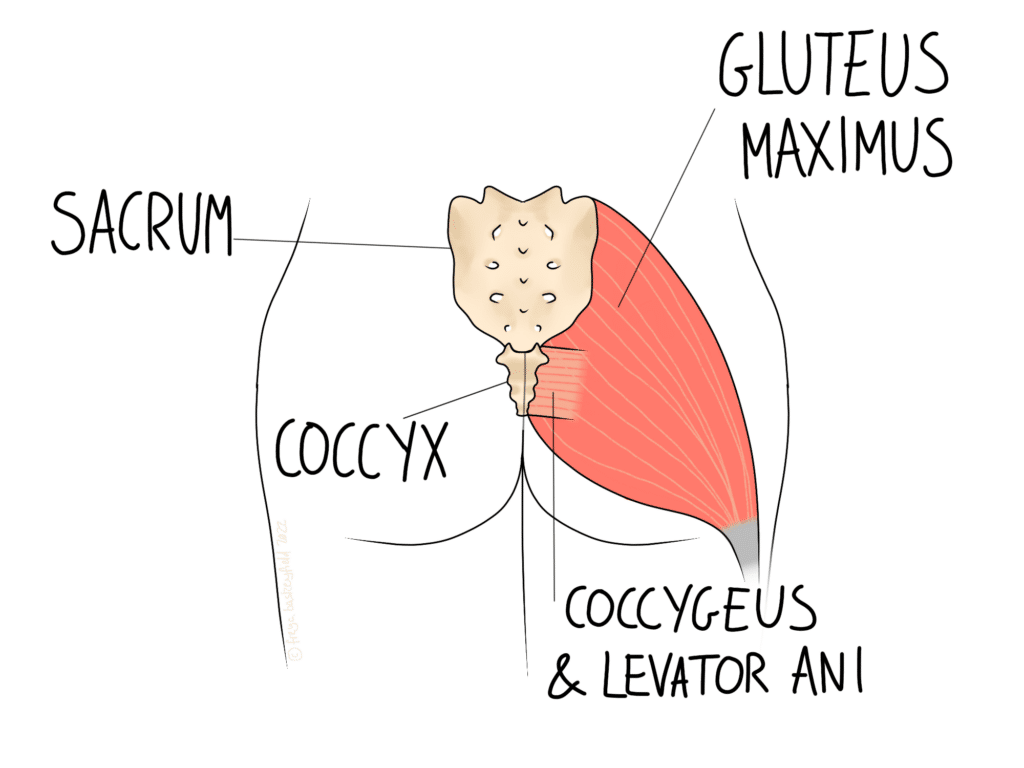

The formal name for the tailbone is the coccyx, so “coccydynia” is a direct translation of “tailbone pain”. This pain can be debilitating, and some people find its intimate location makes the whole problem a bit embarrassing. Your osteopath can work to help relieve your pain, and you can expect a considerate, empathetic experience.

At the base of the spine, some bones are fused to form the sacrum: one large bone at the back of the pelvis. A final bone sits below that, and this is the tailbone. Its only bony joint is to the sacrum, but it is connected to muscles and ligaments all around. The coccyx makes contact with the seat while sitting, so sitting normally can be very difficult while suffering from tailbone pain. Prolonged or repeated sitting on a hard surface can also cause the pain in the first place.
The strong gluteal muscles attach to the sides, and pelvic floor muscles attach to the front.
Knowing about the coccyx’s close relationship with the pelvic floor, it’s easy to see how a problem with the coccyx could also cause problems with continence and comfort in the saddle area.
Coccyx fractures and other injuries can occur from falls onto the tailbone. Falling backwards or falling in a sitting position, as when going to sit and missing the chair, are prime examples of the mechanism. These injuries may also cause a fracture, or cause the tailbone to get stuck in an unusual position.
The pelvic pressures of pregnancy, and the physical nature of childbirth can initiate a coccyx problem.
A computer simulation of the birthing process found that when the coccyx is allowed to move freely, then it can move nearly 16 degrees (making more space for the baby’s head to come down and out through the pelvis). In contrast, when non-flexible sacrum positions are used, the coccyx can only move about 4 degrees (Borges et al., 2021).
Researchers have found consistent evidence that positions that take the weight off the sacrum/coccyx and allow the pelvis to expand can make spontaneous birth (birth without the use of surgery, vacuum, or forceps assistance) more likely (Edqvist et al., 2016).
Evidence Based Birth
Bear in mind that not all cases are traumatic. Pain may develop slowly in cases where the joint is especially stiff or over-flexible. Lower back pain or arthritis can also play a role.
Simple coccydynia may respond quickly to hands-on treatment. This might involve working on the local muscles and providing stretching exercises to keep the tension off the bone. Treatment to improve joint movement in the lower back and rest of the pelvis may also be helpful.
When pain has been present for over 6 months, it counts as chronic pain. At this point, the brain may begin to process the pain differently, making the problem more complicated. You may develop heightened sensitivity to pain in the area. You may also find that non-painful stimuli (like clothes rubbing on the skin) become painful. This is a bit more tricky to manage, but we still have some tools in our kit that might help. Alongside methods mentioned above, we can also work to desensitise the nerves through gentle exposure
90% of coccydynia cases respond well to conservative treatment. If you’re suffering, don’t put it off out of embarrassment or the belief that it’s just something you have to live with now. All of our techniques are external, and you will not be asked to undress any more than you are comfortable to. We will explain everything as we go, and nothing will be done without your explicit consent.
Click here to make an appointment in Leicestershire or Rutland.